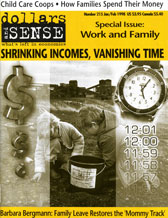
Dear Dr. Dollar:
What is going on with the “Asian Crisis” talked about so much these days? Even though Thailand and Malaysia seem to be hardest hit, how does it affect other Far-East markets?
—Ross Tippit (via email)
This article is from the January/February 1998 issue of Dollars and Sense: The Magazine of Economic Justice available at http://www.dollarsandsense.org
This article is from the January/February 1998 issue of Dollars & Sense magazine.

So how did the miracle economies of Southeast Asia, among the fastest growing in the world, get in trouble? Indonesia, Malaysia, and Thailand grew rapidly for most of 30 years and were still growing between 7.8% and 9% a year in the three years before the currency debacle.
But capitalist booms bring with them tremendous instabilities, especially those produced by exports, as was the case in Thailand. High levels of direct foreign investment in manufacturing—mostly from Japan—supercharged the Thai export sector, which often grew with few links to the domestic economy. Most of the products were made from components imported from Japan, so their export did little to close a widening trade deficit. The deficit was not a problem so long as the Japanese continued to pour money into Thailand. But after 1990, Japanese capital went increasingly to China. Making matters worse, the Thai export boom began to slow in 1996 as international markets for Thai products from autos to computer chips were glutted.
The drop in exports and the slowdown in Japanese investment left Thailand desperate to attract new money. Thai corporate borrowing and foreign financial investment mushroomed. Thai financial and other corporations rung up the highest levels of debt in the region—18% of total economic output (GDP). This debt fueled a speculative binge in everything from high-rise office towers to golf resorts, making Thailand especially vulnerable to a financial collapse. Staggering inequalities of wealth and empty office buildings only added to these problems.
As these investments turned sour, bad debts mounted. With some $15 billion of that debt coming due by the end of 1997, and with the loss of income from exports, the speculative bubble burst last summer. Both foreign and local investors began withdrawing funds. In July, the Thai authorities stopped buying the Thai currency on the open market with their reserve of dollars to shore up its value in relation to other currencies. This effectively “devalued” the currency (called the baht).
So far a cheaper currency has not revived Thai exports (by making Thai goods cheaper abroad) nor brought the return of short term international investors and speculators who’d fled. The Thai stock market lost 70% of its value from its peak in 1994. The baht lost 40% of its value compared to the dollar, forcing Thai corporations to repay their debts in ever more costly dollars.
Enter the International Monetary Fund, the U.S.-dominated agency in charge of policing currency flows on behalf of corporate interests. The IMF extended $22 billion in loans on the condition that the Thais shut down or fix 58 finance companies, limit overseas borrowing, and cut back on government spending. While some Thai elites are feeling the pinch, the financial collapse and the IMF austerity measures are hitting the poor the hardest. Almost 3 million jobs may be lost. Small farmers are no longer able to secure loans and their domestic market has dried up.
The effects of the devaluation of the Thai currency spilled over immediately to other currencies in the region. In Indonesia, where trade deficits are similarly large, borrowing from abroad is equally irresponsible and economic inequality even more pronounced, the currency lost over one-third of its value against the dollar. An IMF-administered austerity program has clamped down on corporate borrowing, closed 16 banks, and cut government spending in return for $40 billion in loans. The IMF forgot to put Indonesia’s horrendous labor practices on their list of needed reforms.
These currency devaluations infected even the more sound economies in the region. In Malaysia, which suffers from a milder version of these same problems, the currency lost one-quarter of its value relative to the dollar, and its stock market plunged. Even Singapore, whose economy boasts little foreign debt and a trade surplus, has seen its currency dragged down 10%.
How big a mess is it? With bad loans in Southeast Asia totaling $73 billion—about 13% of the region’s economic output—the crisis is in relative terms already larger than the U.S. savings and loan crisis during the 1980s. The IMF’s $63 billion bailout—$130 billion including Korea—tops the U.S.-financed bailout of Mexico in 1995. Still, so far the direct effect on the U.S. economy has been limited due to weak trading ties. As the crisis spreads to South Korea, an important U.S. trading partner, the United States could feel the impact.
While reckless local and international capitalists brought on the crisis, we must wait to see if sustained growth returns and, more importantly, if social movements in these countries use the moment to push for more equitable economic development.
Did you find this article useful? Please consider supporting our work by donating or subscribing.
